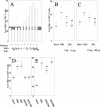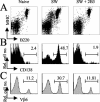Passive immunization with neutralizing antibodies interrupts the mouse mammary tumor virus life cycle
- PMID: 12915552
- PMCID: PMC187390
- DOI: 10.1128/jvi.77.17.9369-9377.2003
Passive immunization with neutralizing antibodies interrupts the mouse mammary tumor virus life cycle
Abstract
Mouse mammary tumor virus (MMTV) infects the host via mucosal surfaces and exploits the host immune system for systemic spread and chronic infection. We have tested a neutralizing rat monoclonal antibody specific for the retroviral envelope glycoprotein gp52 for its efficiency in preventing acute and chronic mucosal and systemic infection. The antibody completely inhibits the superantigen response and chronic viral infection following systemic or nasal infection. Surprisingly however, the antibody only partially inhibits the early infection of antigen-presenting cells in the draining lymph node. Despite this initially inefficient protection from infection, superantigen-specific B- and T-cell responses and systemic viral spread are abolished, leading to complete clearance of the retroviral infection and hence interruption of the viral life cycle. In conclusion, systemic neutralizing monoclonal antibodies can provide an efficient protection against chronic retroviral amplification and persistence.
Figures





Similar articles
-
Immunization with a mouse mammary tumour virus envelope protein epitope protects against tumour formation without inhibition of the virus infection.J Gen Virol. 1997 Aug;78 ( Pt 8):1935-9. doi: 10.1099/0022-1317-78-8-1935. J Gen Virol. 1997. PMID: 9266991
-
Early neutralizing antibody response against mouse mammary tumor virus: critical role of viral infection and superantigen-reactive T cells.J Immunol. 1997 Sep 15;159(6):2807-14. J Immunol. 1997. PMID: 9300703
-
B and T cells are required for mouse mammary tumor virus spread within the mammary gland.J Immunol. 1998 Sep 1;161(5):2375-82. J Immunol. 1998. PMID: 9725233
-
Immune response to MMTV infection.Front Biosci. 2007 Jan 1;12:1594-609. doi: 10.2741/2172. Front Biosci. 2007. PMID: 17127406 Review.
-
Superantigens and retroviral infection: insights from mouse mammary tumor virus.Immunol Today. 1994 Apr;15(4):184-90. doi: 10.1016/0167-5699(94)90317-4. Immunol Today. 1994. PMID: 8198710 Review.
Cited by
-
Oncogenic Viruses and Breast Cancer: Mouse Mammary Tumor Virus (MMTV), Bovine Leukemia Virus (BLV), Human Papilloma Virus (HPV), and Epstein-Barr Virus (EBV).Front Oncol. 2018 Jan 22;8:1. doi: 10.3389/fonc.2018.00001. eCollection 2018. Front Oncol. 2018. PMID: 29404275 Free PMC article. Review.
-
Catching viral breast cancer.Infect Agent Cancer. 2021 Jun 10;16(1):37. doi: 10.1186/s13027-021-00366-3. Infect Agent Cancer. 2021. PMID: 34108009 Free PMC article. Review.
References
-
- Acha-Orbea, H., R. M. Zinkernagel, and H. Hengartner. 1985. Cytotoxic T cell clone-specific monoclonal antibodies used to select clonotypic antigen-specific cytotoxic T cells. Eur. J. Immunol. 15:31-36. - PubMed
-
- Allan, C. H., and J. S. Trier. 1991. Structure and permeability differ in subepithelial villus and Peyer's patch follicle capillaries. Gastroenterology 100:1172-1179. - PubMed
-
- Ardavin, C., P. Martin, I. Ferrero, I. Azcoitia, F. Anjuere, H. Diggelmann, F. Luthi, S. Luther, and H. Acha-Orbea. 1999. B cell response after MMTV infection: extrafollicular plasmablasts represent the main infected population and can transmit viral infection. J. Immunol. 162:2538-2545. - PubMed
-
- Astori, M., and O. Karapetian. 1998. Antibodies to the C-terminal dipeptide of mouse mammary tumor virus [MMTV(SW)] superantigen effectively inhibit T-cell activation in vivo. J. Gen. Virol. 79:57-60. - PubMed
Publication types
MeSH terms
Substances
LinkOut - more resources
Full Text Sources
Other Literature Sources

